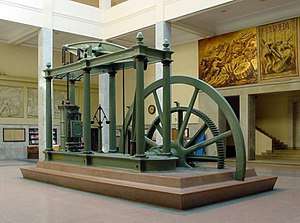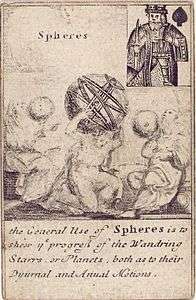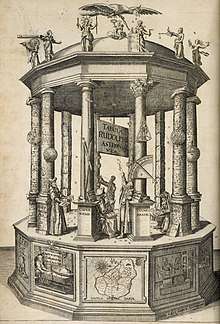History of engineering
The concept of engineering has existed since ancient times as humans devised fundamental inventions such as the pulley, lever, and wheel. Each of these inventions is consistent with the modern definition of engineering, exploiting basic mechanical principles to develop useful tools and objects.

The term engineering itself has a much more recent etymology, deriving from the word engineer, which itself dates back to 1325, when an engine’er (literally, one who operates an engine) originally referred to "a constructor of military engines."[1] In this context, now obsolete, an "engine" referred to a military machine, i. e., a mechanical contraption used in war (for example, a catapult). The word "engine" itself is of even older origin, ultimately deriving from the Latin ingenium (c. 1250), meaning "innate quality, especially mental power, hence a clever invention."[2]
Later, as the design of civilian structures such as bridges and buildings matured as a technical discipline, the term civil engineering[3] entered the lexicon as a way to distinguish between those specializing in the construction of such non-military projects and those involved in the older discipline of military engineering (the original meaning of the word "engineering," now largely obsolete, with notable exceptions that have survived to the present day such as military engineering corps, e. g., the U. S. Army Corps of Engineers).
Ancient era
The ziggurats of Mesopotamia, the pyramids and Pharos of Alexandria in ancient Egypt, cities of the Indus Valley Civilization, the Acropolis and Parthenon in ancient Greece, the aqueducts, Via Appia and Colosseum in the Roman Empire, Teotihuacán, the cities and pyramids of the Mayan, Inca and Aztec Empires, and the Great Wall of China, among many others, stand as a testament to the ingenuity and skill of the ancient civil and military engineers.
The six classic simple machines were known in the ancient Near East. The wedge and the inclined plane (ramp) were known since prehistoric times.[4] The wheel, along with the wheel and axle mechanism, was invented in Mesopotamia (modern Iraq) during the 5th millennium BC.[5] The lever mechanism first appeared around 5,000 years ago in the Near East, where it was used in a simple balance scale,[6] and to move large objects in ancient Egyptian technology.[7] The lever was also used in the shadoof water-lifting device, the first crane machine, which appeared in Mesopotamia circa 3000 BC,[6] and then in ancient Egyptian technology circa 2000 BC.[8] The earliest evidence of pulleys date back to Mesopotamia in the early 2nd millennium BC,[9] and ancient Egypt during the Twelfth Dynasty (1991-1802 BC).[10] The screw, the last of the simple machines to be invented,[11] first appeared in Mesopotamia during the Neo-Assyrian period (911-609) BC.[12] The Egyptian pyramids were built using three of the six simple machines, the inclined plane, the wedge, and the lever, to create structures like the Great Pyramid of Giza.[13]
The earliest architect known by name is Imhotep.[3] As one of the officials of the Pharaoh, Djosèr, he probably designed and supervised the construction of the Pyramid of Djoser (a Step Pyramid) at Saqqara in Egypt around 2630-2611 BC.[14] He may also have been responsible for the first known use of columns in architecture.
The earliest practical water-powered machines, the water wheel and watermill, first appeared in the Persian Empire, in what are now Iraq and Iran, by the early 4th century BC.[15]
Ancient Greece developed machines both in the civilian and military domains. The Antikythera mechanism, an early known model of a mechanical analog computer, and the mechanical inventions of Archimedes, are examples of Greek mechanical engineering. Some of Archimedes' inventions, as well as the Antikythera mechanism, required sophisticated knowledge of differential gearing or epicyclic gearing, two key principles in machine theory that helped design the gear trains of the Industrial revolution and are still widely used today in diverse fields such as robotics and automotive engineering.[16]
Chinese and Roman armies employed complex military machines including the Ballista and catapult. In the Middle Ages, the Trebuchet was developed.
Middle Ages
The earliest practical wind-powered machines, the windmill and wind pump, first appeared in the Muslim world during the Islamic Golden Age, in what are now Iran, Afghanistan, and Pakistan, by the 9th century AD.[17][18][19][20] The earliest practical steam-powered machine was a steam jack steam turbine, described in 1551 by Taqi al-Din Muhammad ibn Ma'ruf in Ottoman Egypt.[21][22]
The cotton gin was invented in India by the 6th century AD,[23] and the spinning wheel was invented in the Islamic world by the early 11th century,[24] both of which were fundamental to the growth of the cotton industry. The spinning wheel was also a precursor to the spinning jenny, which was a key development during the early Industrial Revolution in the 18th century.[25] The crankshaft and camshaft were invented by Al-Jazari in Northern Mesopotamia circa 1206,[26][27][28] and they later became central to modern machinery such as the steam engine, internal combustion engine and automatic controls.[29]
The earliest programmable machines were developed in the Muslim world. A music sequencer, a programmable musical instrument, was the earliest type of programmable machine. The first music sequencer was an automated flute player invented by the Banu Musa brothers, described in their Book of Ingenious Devices, in the 9th century.[30][31] In 1206, Al-Jazari invented programmable automata/robots. He described four automaton musicians, including drummers operated by a programmable drum machine, where they could be made to play different rhythms and different drum patterns.[32] The castle clock, a hydropowered mechanical astronomical clock invented by Al-Jazari, was the first programmable analog computer.[33][34][35]
Al-Jazari built five machines to pump water for the kings of the Turkish Artuqid dynasty and their palaces. Besides over 50 ingenious mechanical devices, Al-Jazari also developed and made innovations to segmental gears, mechanical controls, escapement mechanisms, clocks, robotics, and protocols for designing and manufacturing methods.
European Renaissance
The first steam engine was built in 1698 by mechanical engineer Thomas Savery. The development of this device gave rise to the industrial revolution in the coming decades, allowing for the beginnings of mass production.
With the rise of engineering as a profession in the 18th century, the term became more narrowly applied to fields in which mathematics and science were applied to these ends. Similarly, in addition to military and civil engineering, the fields then known as the mechanic arts became incorporated into engineering.
The following images are samples from a deck of cards illustrating engineering instruments in England in 1702. They illustrate a range of engineering specializations, that would eventually become known as civil engineering, mechanical engineering, geodesy and geomatics, and so on.
Each card includes a caption explaining the purpose of the instrument:
 Four of hearts: Sea quadrant
Four of hearts: Sea quadrant Nine of diamonds: Dyals (dials)
Nine of diamonds: Dyals (dials) Six of diamonds: Circumferentor
Six of diamonds: Circumferentor Eight of diamonds: the Compass
Eight of diamonds: the Compass King of spades: Spheres
King of spades: Spheres Knave of hearts: Surveying wheel and chains
Knave of hearts: Surveying wheel and chains Knave of spades: Leavell
Knave of spades: Leavell One of diamonds: Mathematical instruments
One of diamonds: Mathematical instruments Queen of diamonds: Projections of the sphere
Queen of diamonds: Projections of the sphere.jpg) Queen of spades: Astronomical quadrant
Queen of spades: Astronomical quadrant Three of diamonds: Gauger (gauges)
Three of diamonds: Gauger (gauges) Two of clubs: Theodolet and semi-circle
Two of clubs: Theodolet and semi-circle
Modern era
The inventions of Thomas Savery and the Scottish engineer James Watt gave rise to modern Mechanical Engineering. The development of specialized machines and their maintenance tools during the industrial revolution led to the rapid growth of Mechanical Engineering both in its birthplace Britain and abroad.[3]
The discipline of Electrical Engineering was shaped by the experiments of Alessandro Volta in the 19th century, the experiments of Michael Faraday, Georg Ohm and others and the invention of the electric motor in 1872. Electrical engineering became a profession late in the 19th century. Practitioners had created a global electric telegraph network and the first electrical engineering institutions to support the new discipline were founded in the UK and USA. Although it is impossible to precisely pinpoint a first electrical engineer, Francis Ronalds stands ahead of the field, who created the first working electric telegraph system in 1816 and documented his vision of how the world could be transformed by electricity.[36][37]
The work of James Maxwell and Heinrich Hertz in the late 19th century gave rise to the field of Electronics. The later inventions of the vacuum tube and the transistor further accelerated the development of Electronics to such an extent that electrical and electronics engineers currently outnumber their colleagues of any other Engineering specialty.[3]
Chemical Engineering, like its counterpart Mechanical Engineering, developed in the 19th century during the Industrial Revolution.[3] Industrial scale manufacturing demanded new materials and new processes and by 1880 the need for large scale production of chemicals was such that a new industry was created, dedicated to the development and large scale manufacturing of chemicals in new industrial plants.[3] The role of the chemical engineer was the design of these chemical plants and processes.[3]
Aeronautical Engineering deals with aircraft design while Aerospace Engineering is a more modern term that expands the reach envelope of the discipline by including spacecraft design.[38] Its origins can be traced back to the aviation pioneers around the turn of the 20th century although the work of Sir George Cayley has recently been dated as being from the last decade of the 18th century. Early knowledge of aeronautical engineering was largely empirical with some concepts and skills imported from other branches of engineering.[39] Only a decade after the successful flights by the Wright brothers, the 1920s saw extensive development of aeronautical engineering through development of World War I military aircraft. Meanwhile, research to provide fundamental background science continued by combining theoretical physics with experiments.
The first PhD in engineering (technically, applied science and engineering) awarded in the United States went to Willard Gibbs at Yale University in 1863; it was also the second PhD awarded in science in the U.S.[40]
In 1990, with the rise of computer technology, the first search engine was built by computer engineer Alan Emtage.
See also
References
- Oxford English Dictionary
- Origin: 1250–1300; ME engin < AF esp. mental power, hence a clever invention, equiv. to in- + -genium, equiv. to gen- begetting; Source: Random House Unabridged Dictionary, © Random House, Inc. 2006.
- Engineers' Council for Professional Development definition on Encyclopædia Britannica (Includes Britannica article on Engineering)
- Moorey, Peter Roger Stuart (1999). Ancient Mesopotamian Materials and Industries: The Archaeological Evidence. Eisenbrauns. ISBN 9781575060422.
- D.T. Potts (2012). A Companion to the Archaeology of the Ancient Near East. p. 285.
- Paipetis, S. A.; Ceccarelli, Marco (2010). The Genius of Archimedes -- 23 Centuries of Influence on Mathematics, Science and Engineering: Proceedings of an International Conference held at Syracuse, Italy, June 8-10, 2010. Springer Science & Business Media. p. 416. ISBN 9789048190911.
- Clarke, Somers; Engelbach, Reginald (1990). Ancient Egyptian Construction and Architecture. Courier Corporation. pp. 86–90. ISBN 9780486264851.
- Faiella, Graham (2006). The Technology of Mesopotamia. The Rosen Publishing Group. p. 27. ISBN 9781404205604.
- Moorey, Peter Roger Stuart (1999). Ancient Mesopotamian Materials and Industries: The Archaeological Evidence. Eisenbrauns. p. 4. ISBN 9781575060422.
- Arnold, Dieter (1991). Building in Egypt: Pharaonic Stone Masonry. Oxford University Press. p. 71. ISBN 9780195113747.
- Woods, Michael; Mary B. Woods (2000). Ancient Machines: From Wedges to Waterwheels. USA: Twenty-First Century Books. p. 58. ISBN 0-8225-2994-7.
- Moorey, Peter Roger Stuart (1999). Ancient Mesopotamian Materials and Industries: The Archaeological Evidence. Eisenbrauns. p. 4. ISBN 9781575060422.
- Wood, Michael (2000). Ancient Machines: From Grunts to Graffiti. Minneapolis, MN: Runestone Press. pp. 35, 36. ISBN 0-8225-2996-3.
- Kemp, Barry J. (May 7, 2007). Ancient Egypt: Anatomy of a Civilisation. Routledge. p. 159. ISBN 9781134563883.
- Selin, Helaine (2013). Encyclopaedia of the History of Science, Technology, and Medicine in Non-Westen Cultures. Springer Science & Business Media. p. 282. ISBN 9789401714167.
- Wright, M T. (2005). "Epicyclic Gearing and the Antikythera Mechanism, part 2". Antiquarian Horology. 29 (1 (September 2005)): 54–60.
- Ahmad Y Hassan, Donald Routledge Hill (1986). Islamic Technology: An illustrated history, p. 54. Cambridge University Press. ISBN 0-521-42239-6.
- Lucas, Adam (2006), Wind, Water, Work: Ancient and Medieval Milling Technology, Brill Publishers, p. 65, ISBN 90-04-14649-0
- Eldridge, Frank (1980). Wind Machines (2nd ed.). New York: Litton Educational Publishing, Inc. p. 15. ISBN 0-442-26134-9.
- Shepherd, William (2011). Electricity Generation Using Wind Power (1 ed.). Singapore: World Scientific Publishing Co. Pte. Ltd. p. 4. ISBN 978-981-4304-13-9.
- Taqi al-Din and the First Steam Turbine, 1551 A.D. Archived 2008-02-18 at the Wayback Machine, web page, accessed on line 23 October 2009; this web page refers to Ahmad Y Hassan (1976), Taqi al-Din and Arabic Mechanical Engineering, pp. 34-5, Institute for the History of Arabic Science, University of Aleppo.
- Ahmad Y. Hassan (1976), Taqi al-Din and Arabic Mechanical Engineering, p. 34-35, Institute for the History of Arabic Science, University of Aleppo
- Lakwete, Angela (2003). Inventing the Cotton Gin: Machine and Myth in Antebellum America. Baltimore: The Johns Hopkins University Press. pp. 1–6. ISBN 9780801873942.
- Pacey, Arnold (1991) [1990]. Technology in World Civilization: A Thousand-Year History (First MIT Press paperback ed.). Cambridge MA: The MIT Press. pp. 23–24.
- Žmolek, Michael Andrew (2013). Rethinking the Industrial Revolution: Five Centuries of Transition from Agrarian to Industrial Capitalism in England. BRILL. p. 328. ISBN 9789004251793.
The spinning jenny was basically an adaptation of its precursor the spinning wheel
- Banu Musa (authors), Donald Routledge Hill (translator) (1979), The book of ingenious devices (Kitāb al-ḥiyal), Springer, pp. 23–4, ISBN 90-277-0833-9
- Sally Ganchy, Sarah Gancher (2009), Islam and Science, Medicine, and Technology, The Rosen Publishing Group, p. 41, ISBN 1-4358-5066-1
- Georges Ifrah (2001). The Universal History of Computing: From the Abacus to the Quatum Computer, p. 171, Trans. E.F. Harding, John Wiley & Sons, Inc. (See )
- Hill, Donald (1998). Studies in Medieval Islamic Technology: From Philo to Al-Jazarī, from Alexandria to Diyār Bakr. Ashgate. pp. 231–232. ISBN 978-0-86078-606-1.
- Koetsier, Teun (2001), "On the prehistory of programmable machines: musical automata, looms, calculators", Mechanism and Machine Theory, Elsevier, 36 (5): 589–603, doi:10.1016/S0094-114X(01)00005-2.
- Kapur, Ajay; Carnegie, Dale; Murphy, Jim; Long, Jason (2017). "Loudspeakers Optional: A history of non-loudspeaker-based electroacoustic music". Organised Sound. Cambridge University Press. 22 (2): 195–205. doi:10.1017/S1355771817000103. ISSN 1355-7718.
- Professor Noel Sharkey, A 13th Century Programmable Robot (Archive), University of Sheffield.
- "Episode 11: Ancient Robots", Ancient Discoveries, History Channel, retrieved 2008-09-06
- Howard R. Turner (1997), Science in Medieval Islam: An Illustrated Introduction, p. 184, University of Texas Press, ISBN 0-292-78149-0
- Donald Routledge Hill, "Mechanical Engineering in the Medieval Near East", Scientific American, May 1991, pp. 64–9 (cf. Donald Routledge Hill, Mechanical Engineering)
- Ronalds, B.F. (2016). Sir Francis Ronalds: Father of the Electric Telegraph. London: Imperial College Press. ISBN 978-1-78326-917-4.
- Ronalds, B.F. (July 2016). "Francis Ronalds (1788-1873): The First Electrical Engineer?". Proceedings of the IEEE. doi:10.1109/JPROC.2016.2571358.
- Imperial College London England: Studying engineering at Imperial: Engineering courses are offered in five main branches of engineering: aeronautical, chemical, civil, electrical and mechanical. There are also courses in computing science, software engineering, information systems engineering, materials science and engineering, mining engineering and petroleum engineering.
- Van Every, Kermit E. (1986). "Aeronautical engineering". Encyclopedia Americana. 1. Grolier Incorporated. p. 226.
- Wheeler, Lynde, Phelps (1951). Josiah Willard Gibbs - the History of a Great Mind. Ox Bow Press. ISBN 1-881987-11-6.
Further reading
- Bix, Amy Sue. Girls Coming to Tech!: A History of American Engineering Education for Women (MIT Press, 2014)
- Hill, Donald. A history of engineering in classical and medieval times (Routledge, 2013), on Greeks, Romans, Byzantines, and Arabs
- Lawton, Brian, ed. The Early History of Mechanical Engineering - Vol. 1 (2004) online; vol 2 (2004) online
- Rae, John and Rudi Volti. The Engineer in History (2001) online
- Rhodes, Edward, ed. Engineering America: The Rise of the American Professional Class, 1838–1920 (Washington: Westphalia Press, 2014) 142 pp.
- Smith, Edgar C. A short history of naval and marine engineering (Cambridge University Press, 2013)
- Usher, Abbott Payson. A History of Mechanical Invention (2nd ed. 1954), 450 pp. online review
External links
- History of engineering at University of Minnesota

